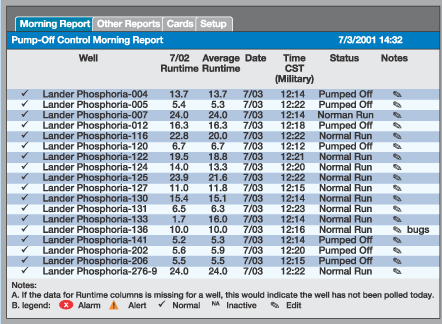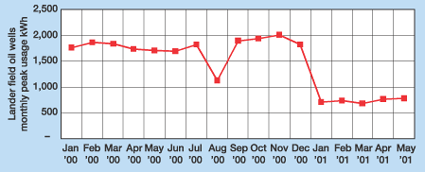Web-based pump-off controller reduces electricity costs
Web-based pump-off controller reduces electricity costsDoug Torr, CamWest, Inc., McKinney, Texas [dtorr@camwestlp.com]; and Dan Mooney, Aurion Technologies, Inc. Dallas, Texas [danmo@auriontech.com] Bottom line. CamWest, Inc., an independent based in Denver, Colorado, and McKinney, Texas, operates more than 120 oil wells in Lander, Wyoming. These wells are located in a remote region that is difficult to reach due to the rough terrain and harsh winter climate. To better manage its waterflood and oil production activities, CamWest installed web-based pump-off controllers. Electricity costs were reduced by about 15%, and the operator fully expects to realize additional value from production optimization, reduced well servicing costs and quicker response times. Operational challenge. For CamWest, like many producers, electrical and well pulling costs are a significant part of the total lease operating expense. In remote areas, operations with manual data retrieval and site inspection complicate things further. Historically, the company’s pump-off controls were activated based on pre-set timing mechanisms not linked to changing well fluid levels. Furthermore, unit failures were primarily discovered by inspecting each individual well through field visits. Many of these breakdowns were the direct result of over-pumping (fluid pound), leading to premature pump or rod failures. As a result, the company experienced higher expenditures and lost production revenue. Solution: Web-based pump-off controllers. To minimize electricity costs, lower repair expenditures and optimize production, CamWest implemented a wireless, electronic pump-off controller (POC) that could be monitored and controlled via the Internet. Aurion Technologies, Inc., a Dallas-based provider of turnkey, web-based telemetry services for oil and gas producers and gas gatherers, provided and installed pump-off control RTUs and a spread-spectrum wireless communication network. The company provides Internet monitoring and support services that include POC software applications within an application service provider (ASP) format. The first 10 POCs were installed in November 2000. By March 2001, 49 POCs had been installed with 51 units being in place at the end of May 2001. Operational results. CamWest utilizes Aurion’s website to monitor fluid level, production and pump-off controller activity, and to control load limits, stroke and load references to activate the pump-off control. The website (Fig. 1) also allows both management and field operations personnel to access various pump-off control reports, such as morning, event and runtime reports; analyze trending and dynagraph card graphics; and allow multiple users to comment on-line about well maintenance issues. Additionally, the website allows users to respond more quickly to equipment problems and production interruption through the receipt of POC data about four times per day.
Typically, a producer’s monthly electricity cost is based on two elements:
By using the pump-off control RTU unit and web software, the operator reduced actual electricity usage (Fig. 2) by maximizing pumping activity during periods of high fluid levels, while eliminating pumping during periods of low fluid levels. Additionally, peak electricity demand usage was reduced by decreasing the rate of pumping activity, Fig. 3.
Economic results. Although the period since technology implementation has been relatively short, CamWest’s utilization of web-based telemetry solutions has already produced significant results. Cost per POC installation was about $2,500, plus a low, monthly service / web monitoring fee. By lengthening the pumping cycle and reducing pumping rate, electricity cost was cut by about 15%, or about $0.16/bbl of oil produced. Electricity costs have dropped from a yearly average of $1.20/bbl of oil in 2000 to $1.04/bbl in 2001 (year-to-date, through May). Electricity cost savings were derived primarily from the operator’s ability to lower peak electricity use by maximizing the pumping activity during periods of high fluid levels and by reducing pump rates over the same period. Actual electricity usage (in terms of kWh) decreased primarily by eliminating pumping during periods of low fluid levels. CamWest also expects to receive additional economic value from production optimization, reducing rod and well repair expenditures and quicker problem solving response time. Lessons learned. The growth of wireless technology and the Internet has enabled the collection of field operating data in remote locations and the use of specific monitoring and control applications via an ASP format. The ability to utilize the Internet for secure data dissemination and as a software application platform allows users from multiple and disparate locations to access and make timely decisions based on current data. The solution outlined for this particular situation, where a communications system had to be established, is cost effective with as few as five wells located in close proximity (within ten miles). If access to cellular is present, it is feasible to automate even a single well. By implementing an Internet-based telemetry system, an independent operator solved the challenge of operating in an isolated, remote location. Wireless, web-based telemetry solutions enabled the producer to optimize production and reduce operating cost by:
|
|||||||||||||||||||||||





